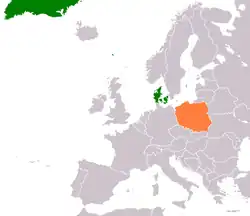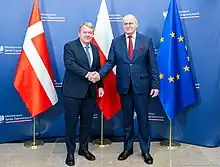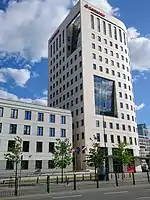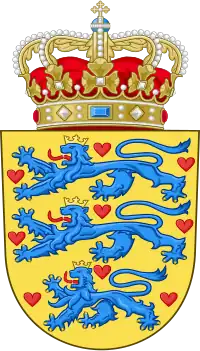Denmark–Poland relations
Denmark–Poland relations refers to the bilateral relations between Denmark and Poland. Relations between the two countries date back to the Middle Ages, while modern diplomatic relations were established on 8 September 1919.[1] During the 20th century, relations were turbulent but amicable.[2] The two countries moreover maintained a maritime border dispute until 2018 when it was delineated.[3]
 | |
Denmark |
Poland |
|---|---|
Both countries are full members of the Council of Europe, European Union, NATO, and the Council of the Baltic Sea States.

History
Early relations
Danish and Polish alliances include those in the 1120s, 1315,[4] 1350,[5] 1363[6] and 1419.[7]
In the medieval period, Poland and Denmark had vivid trade relations and had an alliance against Sweden for the control of the Baltic Sea. Denmark supported the Polish national uprisings when the Polish–Lithuanian Commonwealth fell in 1795.[8]
Modern relations (Interwar period)
Modern relations stem back to the Interwar period. Contacts between Denmark and the new Second Polish Republic began in the first weeks after independence, when Poland asked Denmark to care for Poles in Germany and Russia. On 30 May 1919, Denmark decided to recognize the independence of Poland and diplomatic relations were ultimately established on 8 September 1919.[8] The Polish legation was established in the Hotel Phoenix Copenhagen in 1919 with Aleksander Dzieduszycki as the first representative.[9] In the following months, the Danish legation in Warsaw would send reports back on Polish border conflicts, war with Russia and domestic problems, while the territorial ambitions of the new county were met with caution. Before the Locarno conference in 1925, mainstream Polish media called for Poland and Denmark to cooperate so that both countries could be included in the defense pact negotiated by the Western powers with Germany. However, there was no negotiation and consequently no cooperation. Geographical integration itself was less productive, as Polish politicians simply found it difficult to grasp the Danish security doctrine of supporting disarmament during the interwar period.[8]
A conciliation and arbitration treaty was signed on 23 April 1926. This was followed by a period of systematic contacts aimed at improving mutual familiarity. For example, the fleets of the two countries would make friendly crossings over the Baltic Sea. In 1930, the Danish fleet arrived in Gdynia, while the Polish Dar Pomorza arrived to Denmark in 1933.[8]
Poland generally tried to take a more active role in the Baltic Sea region throughout the 1930s. For this, Denmark was a target of Polish diplomacy because of its advantageous location at the straits that connect the Baltic Sea and the North Sea.[8]
Poland generally tried to take a more active role in the Baltic Sea region throughout the 1930s. Denmark was therefore a target of Polish diplomacy because of its advantageous location at the straits that connect the Baltic Sea and the North Sea. The appointment of Michał Sokolnicki as envoy to Copenhagen in 1931 was one indication of growing Polish interest in Denmark. Sokolnicki was a close friend and associate of Józef Piłsudski during the Polish–Soviet War. In 1934, Polish Foreign Minister Józef Beck visited Copenhagen. However, by the mid-1930s, Danish import of Polish coal decreased due to the end of the coal strike in the United Kingdom.[8]
After the Invasion of Poland in 1939, diplomatic relations were considered legally intact but Denmark went on to withdraw diplomatic recognition of the Polish government-in-exile in July 1945.[10] During World War II, relations were minimal as both countries were occupied by Nazi Germany.[11] During the interwar period, Poland had military intelligence people in Denmark who cooperated with their Danish counterparts against Germany. After the invasion of Denmark in April 1940, these Polish officers fled to Sweden for safety.[12]
Trade relations
After 1926, Poland replaced the United Kingdom as a supplier of coal to Denmark. In 1925, the amount of Polish coal exports was 220,000 tons, 942,000 tons in 1926 and 1.3 million tons in 1927. By 1931, Danish import from Poland amounted to 2.3% while the Polish import of Danish goods was less than one percent. In 1930, Polish Minister of Industry and Trade Eugeniusz Kwiatkowski visited Denmark to strengthen trade relations.[8]
Polish representatives in Denmark
List of Polish representatives of the Second Polish Republic to Denmark:[13]
- Aleksander Dzieduszycki (1919–1924)
- Konstanty Rozwadowski (1924–1928)
- Jan Zygmunt Michałowski (1928–1931)
- Michał Sokolnicki (1931–1936)
- Jan Starzewski (1936–1940)
- Seweryn Sokołowski (designated to succeed Starzewski in 1939)
Relations during the Cold war (1945-1990)
Denmark recognized the Provisional Government of National Unity in Poland on 7 July 1945 and started sending humanitarian aid to Poland that continued after the Cold War had commenced. The period from 1949 to 1953 was the most disconsolate period in the diplomatic relations between the two countries as Denmark had joined NATO and Poland was directly subordinate to Stalin and the Soviet Union. However, two protocols on the claims and compensation for nationalised Danish property were signed in 1949 and 1953.[14]
After the death of Stalin, Denmark joined the Anglo-American strategy of subtly encouraging satellite nations of the Soviet Union to assert their independence by fostering trade and cultural ties with Western nations. In the 1950s, Danish-Polish relations improved with Poland elevating their representation in Copenhagen to an embassy on 15 August 1957 and appointed Stanisław Wincenty Dobrowolski ambassador. Conversely, Denmark appointed their first ambassador to Poland in February 1960. In September 1960, Danish Foreign Minister Jens Otto Krag became the first foreign minister from a NATO country to visit a Soviet satellite state, when he visited Poland to meet Foreign Minister Adam Rapacki. During their meetings, they agreed to avoid provocative military acts in the Baltic Sea. They moreover agreed to develop economic and cultural exchange but Denmark refused to include the Rapacki Plan in their joint communique for fear of it being used as propaganda. Denmark did privately raise the proposal to their NATO allies and did themselves ban the presence of nuclear weapons on their territory. Foreign Minister Rapacki visited Copenhagen in June 1960 where he was received by King Frederik IX and Prime Minister Viggo Kampmann.[14]
By the 1970s, Poland had become the largest trading partner for Denmark among the communist bloc and they moreover began negotiations on finding a solution on the maritime borders in 1972 which would continue until 2018 when Poland handed Denmark 80% of the disputed area. In the 1980s, communication decreased as Denmark joined other Western countries in pressuring Poland to re-establish dialogue with Solidarność and the Church. Only in 1987, did communication normalize as Polish authorities began political reforms and appeared to decompose.[15]
Trade
The following table shows the annual trade numbers between the two countries from 1988 to 2022 in euro:[16]
| Year | Polish imports to Denmark | Danish imports to Poland |
|---|---|---|
| 1988 | €203.16 million | €95.17 million |
| 1989 | €205.43 million | €156.43 million |
| 1990 | €277.88 million | €201.78 million |
| 1991 | €331.32 million | €520.25 million |
| 1992 | €355.83 million | €398.44 million |
| 1993 | €385.41 million | €389.11 million |
| 1994 | €502.82 million | €452.1 million |
| 1995 | €549.27 million | €480.14 million |
| 1996 | €550.44 million | €620.36 million |
| 1997 | €656.39 million | €698.87 million |
| 1998 | €694.05 million | €755.29 million |
| 1999 | €743.49 million | €734.92 million |
| 2000 | €873.42 million | €796.12 million |
| 2001 | €1019.64 million | €850.66 million |
| 2002 | €981.49 million | €856.45 million |
| 2003 | €883.17 million | €812.68 million |
| 2004 | €991.9 million | €849.71 million |
| 2005 | €1167.79 million | €1063.3 million |
| 2006 | €1556.22 million | €1288.83 million |
| 2007 | €1718.52 million | €1559.06 million |
| 2008 | €2012.81 million | €1748.56 million |
| 2009 | €1501.41 million | €1454.68 million |
| 2010 | €1859.08 million | €1600.45 million |
| 2011 | €2124.34 million | €1905.03 million |
| 2012 | €2244.04 million | €1853.19 million |
| 2013 | €2421.24 million | €1909.44 million |
| 2014 | €2414.35 million | €2064.78 million |
| 2015 | €2603.55 million | €2325.2 million |
| 2016 | €2952.44 million | €2301.87 million |
| 2017 | €3249.33 million | €2484.52 million |
| 2018 | €3394.93 million | €2536 million |
| 2019 | €3634.96 million | €3005.81 million |
| 2020 | €3911.15 million | €3243.49 million |
| 2021 | €4535.2 million | €3571.41 million |
Maritime borders
In 2018, Denmark and Poland ended 40 years of maritime border dispute when they signed an agreement concerning 3,600 km2 (1,400 sq mi) of Baltic Sea between Bornholm and Poland, with Denmark receiving 80% of the area.[3] This paved the way for the Baltic Pipe, connecting Norway with Denmark and Poland, which was commissioned in September 2022.[17]
Gallery
 Building hosting the Embassy of Denmark in Warsaw
Building hosting the Embassy of Denmark in Warsaw
 Honorary Consulate of Denmark in Kraków
Honorary Consulate of Denmark in Kraków
Honorary consulates
There are honorary consulates of Denmark in Gdynia, Kraków, Łódź, Poznań, Szczecin and Wrocław,[18] and an honorary consulate of Poland in Aarhus.[19]
See also
- Foreign relations of Denmark
- Foreign relations of Poland
- Franciszek Jarecki - Polish pilot who fled to Denmark on 5 March 1953 with his MiG-15bis aircraft.[14]
References
- "Polska w Danii (Serwis Rzeczypospolitej Polskiej)" (in Polish). Retrieved 12 April 2023.
- "A Centenary of Polish-Danish Relations - Abstract". 2023. Retrieved 7 September 2023.
- "Poland and Denmark sign agreement on maritime boundary in the Baltic Sea". maritime-spatial-planning.ec.europa.eu. 28 November 2018.
- "Wydarzenia z kalendarza historycznego: 27 czerwca 1315". chronologia.pl (in Polish). Retrieved 9 July 2022.
- "Kalendarz dat: 1350". Dzieje.pl (in Polish). Retrieved 9 July 2022.
- "13 grudnia 1363 roku król Polski Kazimierz III Wielki podpisał sojusz z królem duńskim Waldemarem IV". Historykon.pl (in Polish). Retrieved 9 July 2022.
- Jensen, Janus Møller (2007). Denmark and the Crusades, 1400-1650. Leiden/Boston: Brill. p. 56. ISBN 978-90-04-15579-4.
- Jaworski, Paweł (2023). "Episodic neighbourhood? Polish-Danish relations 1918–1939". In Friis, Thomas Wegener; Bułhak, Władysław (eds.). A Centenary of Polish-Danish Relations. pp. 33–36.
- Jaworski, Paweł; Ciechanowski, Jan Stanisław (2023). "Polish envoys to Denmark 1919-1940". In Friis, Thomas Wegener; Bułhak, Władysław (eds.). A Centenary of Polish-Danish Relations. p. 79.
- Ciechanowski, Jan Stanisław (2023). "Polish envoys to Denmark 1919-1940". In Friis, Thomas Wegener; Bułhak, Władysław (eds.). A Centenary of Polish-Danish Relations. p. 87.
- Jaworski, Paweł (2023). Friis, Thomas Wegener; Bułhak, Władysław (eds.). "Introduction - From Re-stablishment to Cooperation". A Centenary of Polish-Danish Relations: 10.
- Władysław, Bułhak; Friis, Thomas Wegener (2023). "Polish Intelligence in Denmark in 1941–1945". A Centenary of Polish-Danish Relations. p. 46.
- Ciechanowski, Jan Stanisław (2023). "Polish envoys to Denmark 1919-1940". In Friis, Thomas Wegener; Bułhak, Władysław (eds.). A Centenary of Polish-Danish Relations. pp. 79–86.
- Tebinka, Jacek (2023). "Reflections on the Cold War encounters". In Friis, Thomas Wegener; Bułhak, Władysław (eds.). A Centenary of Polish-Danish Relations. pp. 105–109.
- Tebinka, Jacek (2023). "Reflections on the Cold War encounters". In Friis, Thomas Wegener; Bułhak, Władysław (eds.). A Centenary of Polish-Danish Relations. pp. 111–112.
- "Imports and exports CN (EU Combined Nomenclature) by unit, country, imports and exports and time". Statistics of Denmark. Archived from the original on 2020-10-26. Retrieved 17 January 2022.
- "Jak sprytnie Polska i Dania podzieliły Bałtyk". www.polska2041.pl (in Polish).
- "Konsulaty Królestwa Danii w Polsce" (in Polish). Retrieved 9 July 2022.
- "Konsulaty honorowe". Portal Gov.pl (in Polish). Retrieved 9 July 2022.
Further reading
- Gawinecka-Woźniak, Magda (2015). Polska-Dania. Stosunki dwustronne w latach 1945-1968 (in Polish). The Nicolaus Copernicus University Press.

